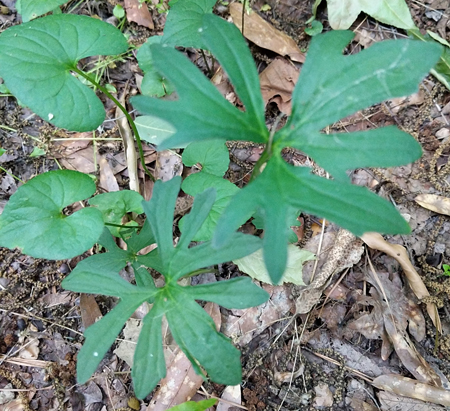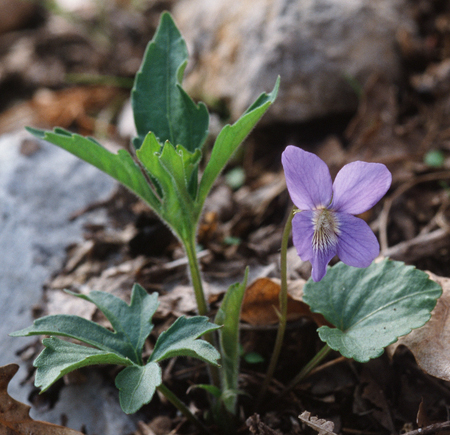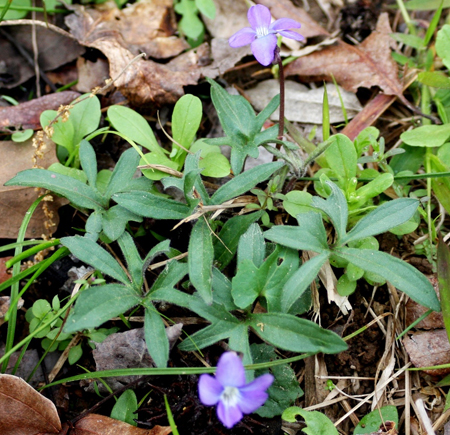Viola palmata L. var. palmata, Sp. pl., ed. 1, 2: 933. 1753
Common names:
Southern Three-lobed Violet
Synonyms:
Viola palmata L. var. palmata, Sp. pl., ed. 1, 2: 933. 1753. TYPE: "Habitat in Virginia." Type: USA, Virginia, [no date], J. Clayton 468 in Herb. Jacquin (lectotype incorrectly designated as holotype by Landon McKinney, Sida, Bot. Misc. 7: 12. 1992: Herb. Linn. No. 1052.1 (LINN), JSTOR Global Plants image!). [According to Charlie Jarvis (pers. comm.), Clayton 468/793 in Herb. Gronovius (BM000042617, JSTOR Global Plants image!) is a duplicate of Clayton 468 at LINN.]
Viola triloba Schwein. f. dilatata (Elliott) E.J.Palmer & Steyerm., Brittonia 10: 115. 1958; Viola triloba Schwein. var. dilatata (Elliott) Brainerd, Bull. Torrey Bot. Club 37: 587. 1911; Viola palmata L. var. dilatata Elliott, Sketch bot. S. Carolina 1(3): 300. 1817 TYPE: "This is the common variety in the upper districts of Georgia and Carolina." [Elliott cited no specific collection, but it is generally accepted that his herbarium is deposited at CHARL. Unfortunately, my thorough examination of his herbarium revealed that at some time subsequent to Elliott's publication, specimens and labels were removed from their sheets and (in many instances) later reattached with no attempt to correctly place labels in association with their original specimens. As a result, none of the published varieties of V. palmata except for var. heterophylla are currently represented in his herbarium with labels or recognizable specimens. Nevertheless, Elliott's description of the present taxon still allows for relatively clear interpretation of which taxon he had in mind. A neotype for var. dilatata must be designated.]
Viola falcata Greene, Pittonia 4: 3. 1899. TYPE: "In oak woods near Cobden, Illinois, 15 June 1898." Type: USA, Illinois, Cobden, 15 Jun 1898, E. L. Greene s.n. (syntypes: NDG33528, NDG33529, NDG33530, NDG33531, NDG33532, all JSTOR Global Plants images!). [The protologue provides fairly specific information indicating one collection, but it makes no reference to a herbarium. None of the sheets listed has any indication of being a type, nor does the protologue specify a single specimen. Must select a lectotype.]
Description:
Foliage and chasmogamous and cleistogamous peduncles moderately to densely hirsute, green, margins of leaf blades ciliate, peduncles moderately hirsute; larger leaf blades deeply pedately divided into 3, 5 or 7(9) linear to rhombic-lanceolate or ovate-lanceolate lobes, the lateral primary divisions sometimes scarcely divided and appearing “dilated”, sinuses between primary divisions reaching nearly or quite to the petiole summit, the longest axis of the lateral primary division or the lobe of the lateral primary division nearest the terminal primary division > 1/2 the length of the midrib; calyx strongly ciliate; lowest sepals oblong-ovate to ovate, obtuse to rounded at apex; cleistogamous capsule heavily purple-spotted or blotched, on an initially prostrate peduncle arching upward abruptly just prior to dehiscence. Other features as in V. palmata sensu lato.
Ecology:
Drier to dry somewhat acidic or somewhat alkaline sandy or sandy loam soils in dry oak and oak-pine woodlands, oak savannas, or open forests on slopes and bluffs.
Distribution:
Atlantic and Gulf Coastal Plains and lower to middle Piedmont in the Southeast, and in the Lower Midwest, VA to TN, w. IN, s. IL and e. KS, south to FL and e. TX.
Rarity:
None.
Phenology:
Phenology presumably the same as V. palmata sensu lato.
Affinities:
This species belongs to the Acaulescent Blue Violet lineage, sect. Nosphinium W.Becker, subsect. Boreali-Americanae (W.Becker) Gil-ad, in the Palmata species group.
Hybrids:
Hybridizes with V. emarginata (Brainerd 1924). Brainerd reported that this exhibits intermediate or recombinant characteristics of foliage, chasmogamous flowers, cleistogamous capsules and seeds (where these did not abort). The hybrid fails to reproduce by chasmogamous flowers and produce either abortive cleistogamous capsules or very few viable seeds.
Comments:
The present taxon, as circumscribed here, is confined to the middle and lower Piedmont and Coastal Plain regions in the southeastern U.S. and in the Lower Midwest. Russell (1965) maps these two regions as separate areas, and further research is needed to determine whether confirmed records bridge this reportedly bimodal distribution. Plants with biternately divided leaf blades from the Appalachian Mountains and Western Allegheny Plateau have previously been included here but these belong to V. "palmata pseudo-stoneana, while plants with biternately divided leaf blades from the Gulf Coastal Plain region west to Arkansas and Oklahoma belong to V. "palmata Red Hills". Even extracting multiple apparently distinct taxa from this melange of variants leaves substantial morphological polymorphism especially in dissection of leaf blades during chasmogamous flower through mid-cleistogamous fruit in var. palmata. de Schweinitz (1822) remarked on this nearly 200 years ago, noting that he had observed nearly every possible variation in this taxon (he may have included several other heterophyllous taxa which were subsequently treated as distinct species). He also stated that Elliott's V. palmata var. dilatata could serve as the type of V. palmata. For more information, see comments under V. palmata sensu lato. Populations in the southeastern region (formerly var. dilatate, now the present taxon) grow in somewhat acidic soils, while those in the Lower Midwest (formerly V. falcata) are commonly on circumneutral or possibly somewhat alkaline often cherty soils overlying limestone.
Literature Cited:
Brainerd, E. 1924. The natural violet hybrids of North America. Vermont Agricultural Experiment Station Bulletin 239: 1-205.
Russell, N. H. 1965. Violets (Viola) of the central and eastern United States: An introductory survey. Sida 2: 1-113.
de Schweinitz, L. D. 1822. Art. X. Attempt of a monography of the Linnaean genus Viola, comprising all the species hitherto observed in North America. American Journal of Science, and Arts 5: 48-81.

Chasmogamous flowering habit by Kim Blaxland, "Botanikim" website (permission granted by Chris Blaxland)

Post-chasmogamous flowering habit (plant from Millbrook, AL) by robjohn, "iNaturalist" website, under Creative Commons license CC by 4.0

Chasmogamous flowering habit (plant from Boone Co., MO) by Kim Blaxland, "Botanikim" website (permission granted by Chris Blaxland)

Chasmogamous flowering habit (plant from near East Hamilton, Texas) by Eric Keith, "iNaturalist" website, under Creative Commons license CC by-NC 4.0

Chasmogamous flower front view (plant from Boone Co., MO) by Kim Blaxland, "Botanikim" website (permission granted by Chris Blaxland)

Map of widespread varieties of V. palmata by Harvey Ballard, adapted from Russell (1965)